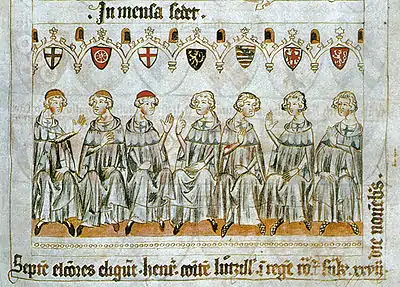Interregnum (Holy Roman Empire)
There were many imperial interregna in the history of the Holy Roman Empire, when there was no emperor. Interregna in which there was no emperor-elect (king of the Romans) were rarer. Among the longest periods without an emperor were between 924 and 962 (38 years), between 1245 and 1312 (67 years), and between 1378 and 1433 (55 years). The crisis of government of the Holy Roman Empire and the German kingdom thus lasted throughout the late medieval period, and ended only with the rise of the House of Habsburg on the eve of the German Reformation and the Renaissance. The term Great Interregnum is occasionally used for the period between 1250 (death of Frederick II) and 1273 (accession of Rudolf I).
Great Interregnum
| |||
Result: compromise
|
After the deposition of Frederick II by Pope Innocent IV in 1245, Henry Raspe, Landgrave of Thuringia was set up as anti-king to Frederick's son Conrad IV (d. 1254). Henry was killed in 1247 and succeeded as anti-king by William of Holland (died 1256). After 1257, the crown was contested between Richard of Cornwall, who was supported by the Guelph party, and Alfonso X of Castile, who was recognized by the Hohenstaufen party but never set foot on German soil. After Richard's death in 1273, Rudolf I of Germany, a minor pro-Staufen count, was elected. He was the first of the Habsburgs to hold a royal title, but he was never crowned emperor. After Rudolf's death in 1291, Adolf and Albert were two further weak kings who were never crowned emperor.
Albert was assassinated in 1308. Almost immediately, King Philip IV of France began aggressively seeking support for his brother, Charles of Valois, to be elected the next King of the Romans.[1] Philip thought he had the backing of the French Pope Clement V (established at Avignon in 1309), and that his prospects of bringing the empire into the orbit of the French royal house were good. He lavishly spread French money in the hope of bribing the German electors.[2] Although Charles of Valois had the backing of Henry, Archbishop of Cologne, a French supporter, many were not keen to see an expansion of French power, least of all Clement V.[2][3] The principal rival to Charles appeared to be Rudolf, the Count Palatine.
Instead, Henry VII, of the House of Luxembourg, was elected with six votes at Frankfurt on 27 November 1308.[2] Given his background, although he was a vassal of king Philip,[2] Henry was bound by few national ties, an aspect of his suitability as a compromise candidate among the electors,[4] the great territorial magnates who had lived without a crowned emperor for decades, and who were unhappy with both Charles and Rudolf. Henry of Cologne's brother, Baldwin, Archbishop of Trier, won over a number of the electors, including Henry, in exchange for some substantial concessions.[2] Henry VII was crowned king at Aachen on 6 January 1309, and emperor by Pope Clement V on 29 June 1312 in Rome, ending the interregnum.
Later interregna


However, political instability in Germany re-emerged after Henry's untimely death in 1314. Louis IV was opposed by Frederick the Fair, and later by Charles IV, and Charles IV in turn (briefly) by Günther of Schwarzburg, ruling unopposed only from 1350. His successors Wenceslaus, Rupert and Jobst again were not crowned emperor. Sigismund (r. 1411–1437) was crowned emperor in 1433, but only with Frederick III (r. 1452–1493), the second emperor of the House of Habsburg, did the Holy Roman Emperor return to an unbroken succession of emperors (with the exception of Charles VII all of the House of Habsburg) until its dissolution in 1806.
The crisis of the interregnum established the college of prince-electors as the only source of legitimacy of the German king. At the same time, the lack of central government strengthened the communal movements, such as the Swabian League of Cities, the Hanseatic League and the Swiss Confederacy. It also encouraged increased feuding among the lesser nobility, leading to conflicts such as the Thuringian Counts' War, leading to a general state of near-anarchy in Germany where robber barons acted unopposed by the nominal system of justice. Germany was fractured into countless minor states fending for themselves, a condition that would persist into the modern period and, termed Kleinstaaterei, present an obstacle to the modern project of national unification.
See also
- Anti-king#Germany
- Count-kings
- Crisis of the Late Middle Ages
- Feudalism in the Holy Roman Empire
- Formation of the Old Swiss Confederacy
- Guelphs and Ghibellines
- Hanseatic League
- Imperial immediacy
- Interrex
- List of German monarchs
- Medieval commune
- Prince-elector
- Städtebund
- Translatio imperii
- Western Schism
References
- Jones, pg. 529
- Jones (2000), p. 530.
- Comyn, p. 408
- Comym, pg. 410
Literature
- Comyn, Robert. History of the Western Empire, from its Restoration by Charlemagne to the Accession of Charles V, Vol. I. 1851
- Hägermann, Dieter. Interregnum. In: Lexikon des Mittelalters. Band 5. Sp. 468 f.
- Jones, Michael, The New Cambridge Medieval History, Vol. VI: c. 1300-c. 1415, Cambridge University Press, 2000
- Kaufhold, Martin. Deutsches Interregnum und europäische Politik. Konfliktlösungen und Entscheidungsstrukturen 1230–1280. Hahn, Hannover 2000, ISBN 3-7752-5449-8 (= Monumenta Germaniae Historica. Schriften. Band 49.
- LaRoche, Emanuel Peter. Das Interregnum und die Entstehung der Schweizerischen Eidgenossenschaft. Peter Lang, Bern / Frankfurt am Main 1991 (= Geist und Werk der Zeiten, Band 30).
- Kaufhold, Martin. Interregnum. Wissenschaftliche Buchgesellschaft, Darmstadt 2003, ISBN 3-534-15450-9.
- Prietzel, Malte. Das Heilige Römische Reich im Spätmittelalter. Wissenschaftliche Buchgesellschaft, Darmstadt 2004, ISBN 3-534-15131-3.
- Kirk, Marianne. «Die kaiserlose, die schreckliche Zeit» – Das Interregnum im Wandel der Geschichtsschreibung, Frankfurt/M. u.a. 2002, ISBN 978-3-631-50542-7
- Stadler, Hans: Interregnum in German, French and Italian in the online Historical Dictionary of Switzerland, 2007.